10 Years After Launch, Nalanda Still Innovates
Written by: Diane Brooks
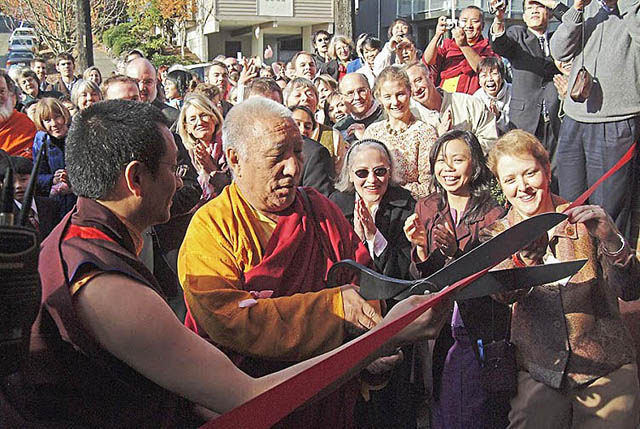
Dzogchen Ponlop Rinpoche, left, and Khenpo Tsültrim Gyamtso Rinpoche, cut the ribbon to open Nalanda West in November 2004 while Lynne Marvet, right, beams.
Photos by: Katrin Brüggemann, Rysiek Frackiewicz, Scott Pownall, James Prouty
The joy is palpable; faces aglow with the auspiciousness of the moment and the warmth of Seattle’s precious sunshine.
Images from the November, 2004 inauguration of Nalanda West, the international home of Dzogchen Ponlop Rinpoche’s Nalandabodhi organization, capture the wonderment and excitement of his fledgling sangha.
“It was a very powerful moment of beginning something new,” said Lynne Marvet, one of Ponlop Rinpoche’s earliest students who, along with her husband, Marty Marvet, helped orchestrate the $2.1 million property purchase.
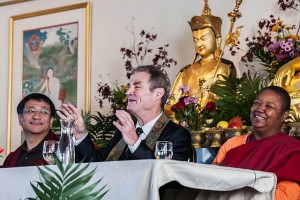
Nalanda West celebrated its 10th birthday with a Nov. 16, 2014, “Awake in Seattle” public event. Left to right: panelists Dzogchen Ponlop Rinpoche, John Tarrant Roshi, and Ven. Pannavati.
A whirlwind of volunteer labor had transformed the impressive brick structure from a tired, dingy Korean Presbyterian church into a modern dharma center, which could play an important role in the evolution of a new, Westernized flavor of Tibetan Buddhism.
Now the sangha is celebrating its 10-year birthday, looking back upon a decade of growth – both spiritual and physical.
“It was full of challenges,” said Robert Fors, an early student who played a pivotal role in the development of the Nalanda West events center. “How do we make the programming attractive to a larger community, so it’s not just a small Buddhist audience?”
Ponlop Rinpoche’s vision of an evolving American melting pot of Buddhist traditions is reflected in the diversity of Nalanda West’s offerings. While Ponlop Rinpoche is a prominent lineage holder of the Nyingma and Kagyu schools of Tibetan Buddhism, his Seattle center has hosted teachers from a range of other traditions. Eco-philosopher Joanna Macy, for instance, is a Theravada practitioner; John Tarrant Roshi is a Zen koan master.
“I think [Ponlop Rinpoche] has a very clear vision of how the dharma is now in the process of transformation, having more voices,” said Tarrant, who took part in Nalanda West’s recent birthday celebration. “He has, of course, a very deep connection with the great Tibetan traditions, and at the same time is very curious about how that will evolve outside the original cultural context.”
When Ponlop Rinpoche and his own guru, Khenpo Tsültrim Gyamtso Rinpoche, together snipped the shiny red ribbon in 2004 to formally open Nalanda West, Nalandabodhi’s Seattle sangha counted about 35 members.
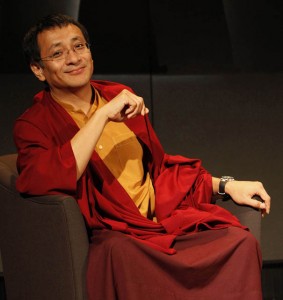
Dzogchen Ponlop Rinpoche.
Today the Seattle sangha has 136 members, while the global Nalandabodhi organization – including centers in Canada, Mexico, Asia and Europe – has swelled to about 700 students.
The decade of growth has included an ongoing development of printed materials and classes to present Ponlop Rinpoche’s teachings on the paths of study, meditation and “mindful activity,” which is applying the teachings to one’s daily life. The materials are systematized in a Western-style academic structure, with 100-level courses for an introductory series of classes (free to the public on Wednesday nights,) 200-level for the Hinayana, 300-level for the Mahayana, and 400-level for the Vajrayana.
“It’s unusual to have a course of study that’s so methodical and comprehensive, that covers beginning, intermediate and advanced levels,” said Mark Power, one of Nalandabodhi’s four mitras, or senior teachers.
“I think we’re like some kind of trailblazers,” Ponlop Rinpoche told his students during the recent birthday events.
The traditional Buddhist focus on the “five fields of knowledge” – creativity and the arts, health and wellbeing, communication, knowledge and reasoning, and the inner science of mind – is embedded within Nalanda West’s program offerings.
But over time, Ponlop Rinpoche has stripped away many of the traditional Tibetan cultural accouterments typically associated with Vajrayana Buddhism. Longtime students recall an early preoccupation with outward forms: a flurry of full prostrations when a teacher entered the room; lots of red protection cords and white katas (scarves;) conspicuous malas (prayer beads;) and concerns about placing ornate brocades on a teacher’s seat and cloths over water glasses, both vestiges from a time when teachings took place in dirty, dusty locales.
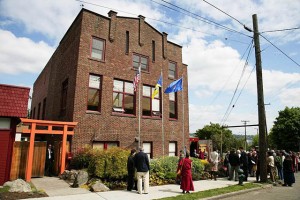
Exterior of Nalanda West, during the 17th Karmapa’s 2008 visit.
“There was a confusion about what’s Tibetan and what’s Buddhism,” said Carmen Rumbaut, a student of both Khenpo Rinpoche and Ponlop Rinpoche, whom she met in 1996.
Now sangha gatherings are more joyous, she said, as students let go of worries and tensions and relax into their practices.
Ponlop Rinpoche often offers an analogy, Rumbaut said, comparing Buddhism to water that can be poured into various cultural containers. “It takes the flow and shape of the container, but the water is still pure,” she said.
He voiced a parallel analogy during the recent birthday events.
“American Buddhism … can be like our ideal melting pot. All the Buddhist traditions can come together without losing each individual’s own tradition and authenticity,” said Ponlop Rinpoche. “I hope someday we can find that … ideal American Buddhism, dissolving all the unnecessary cultural trappings while maintaining the essence of the wisdom and compassion together.”
Nalanda West’s physical container has been distinctive from the start, with a spare elegance that reflects Ponlop Rinpoche’s preference for an open and spacious aesthetic.
“Rinpoche said he wants it simple, but beautiful and powerful,” Fors said.
Traditional thangka paintings are hung in Western frames, rather than sewn into elaborate brocades; the green marble shrine supports only three golden statues – of Buddha, Guru Rinpoche and Green Tara – commissioned from Thailand by Ponlop Rinpoche.
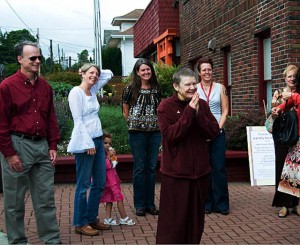
Pema Chodron visits Nalanda West in 2009, when the organization sponsored her teachings at the University of Washington.
“Rinpoche is consciously co-creating American Buddhism with us, in a way that honors our traditions and the Tibetan heritage he came from,” said Nick Vail, a co-director of the Seattle sangha. “He’s not trying to transplant it from Tibet or Nepal, but rather co-creating a living lineage of awakening that transcends culture.”
When Ponlop Rinpoche moved from Vancouver, B.C. to Seattle in 2001, his North American students were scattered across the U.S. and Canada. Rumors of his plan to create a headquarters and event center, confirmed with the 2003 purchase of the Nalanda West property, began inspiring some to relocate to Puget Sound. That trend accelerated after the inauguration, with an especially notable influx of students from Boulder, Colo.
The charismatic, young Rinpoche had magnetized students at Boulder’s Naropa University, where he taught for several semesters in the late 1990s. Naropa was founded by Chögyam Trungpa Rinpoche, a major force in the introduction of Vajrayana Buddhism to Western audiences, who died in 1987.
“[Ponlop Rinpoche] was this savvy, dynamic, English-speaking teacher who was brilliant – incredibly well-versed in all forms of Tibetan scholarly endeavors,” said Lynne Marvet, his travel secretary during those years. “So funny. Ridiculous sense of humor, with contemporary references. In those days, it was ‘The X Files’ –‘The Truth is Out There,’ ” she said, laughing at the memory. “People hadn’t seen anything quite like him.”
Fors and his wife, Cindy Shelton, were among his early Boulder devotees. In 1996, they formally asked Ponlop Rinpoche to establish his own sangha. When he agreed, about 40 students began meeting in their living room: the birthplace of the international Nalandabodhi organization.
Ponlop Rinpoche had galvanized the Naropa academic community with his dynamic, interactive and comprehensive teaching style, Shelton said. “People were really investigating reality,” she said. “He brought (the teachings) to life in a in a way we had never heard before.”
Part of his charm, she said, was his presentation of himself as “an ordinary person,” eschewing traditional pomp and circumstance, despite his status as one of the world’s highest-ranking teachers in both the Nyingma and Kagyu lineages. The 16th Karmapa, who recognized him at his 1965 birth in India as the seventh Dzogchen Ponlop Rinpoche, provided much of his early training.
“He joked with people; he liked the Rolling Stones; he liked rock ‘n’ roll; he ate hamburgers; he was just so friendly and ordinary, he talked to people on their level,” Shelton said. “He was just very current with Western culture. People were so delighted with his humor, combined with that kind of brilliance. It was just really extraordinary.”
At that point Ponlop Rinpoche still was based in Vancouver, B.C., while accepting teaching invitations from around the world. Meanwhile, his North American students were beginning to meet and intermingle at the annual Treasury of Knowledge retreat in San Antonio, Texas, where he has taught since 1992.
With encouragement from his guru, Khenpo Rinpoche, Ponlop Rinpoche began exploring the idea of establishing a retreat center in the Pacific Northwest. He already had a strong heart connection with the United States, which began at age 14 when he accompanied the 16th Karmapa on an eight-month visit. He later attended Columbia University, in New York City, in addition to his classic studies in India at Rumtek Monastery’s monastic college, where he graduated at the top of his class.
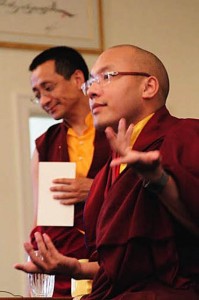
Dzoghen Ponlop Rincpoche, left, with the 17th Karmapa during the latter’s May, 2008 Seattle visit.
Shelton and Fors moved to Seattle in Fall 1998, to help scout for property for the proposed center. And the Seattle sangha was born – as before, in their living room – with seven students.
As word spread about the new endeavor, other students began moving to Seattle. The Marvets, for instance, arrived from New York City in 1999.
The international sangha’s tradition of coming together for an annual retreat, with teachings from Ponlop Rinpoche, began that spring. The group rented a Boy Scout camp in the mountains near Ellensburg, in Eastern Washington. About 65 students attended, many traveling from British Columbia, San Francisco and Boulder.
This year’s sangha retreat, at Nalanda West, drew about 175 students from around the globe.
Over the next few years, Fors led a group searching for property for a permanent retreat center. Meanwhile, the growing sangha continued to meet in their home. At one point, the magnificent golden Buddha statue which today is the focal point of the Nalanda West shrine room sat in their living room.
In 2000, the sangha began renting a temporary headquarters in Seattle’s University District.
The November 2002 discovery – and immediate selection – of the Korean church stunned the group, which was looking at smaller, more affordable options, in the $500,000 price range. Khenpo Rinpoche was in town for a teaching, so he came along for the property visit.
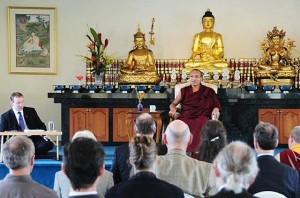
The 17th Karmapa gives a teaching in Nalanda West’s shrine room in 2008.
Ponlop Rinpoche remembers standing with his guru on the stage in the present-day shrine room. Khenpo Rinpoche gazed at the downtown Seattle skyline, visible through a row of south-facing windows, then turned to look at a large wooden cross on the wall behind them.
“Then he looked at me and said, ‘This is it. We should get it,’ ” said Ponlop Rinpoche.
It took nearly a year to finalize the sale, which required a $1 million loan. The Marvets tackled the legal and financial paperwork needed to buy the .64-acre site, south of Green Lake near the Fremont district, which includes a small office building and three residential bungalows. Fors and Shelton were among the co-signers.
The main building needed an immediate makeover. The deal closed in October 2003, just three weeks before Khenpo Rinpoche was scheduled to give a nine-day teaching. About 30 people leaped into action.
“It was a pouring-rain weekend, and the whole place flooded,” Fors said. “Everybody – the lamas, [Ponlop] Rinpoche – was painting and pulling down walls and setting up stuff.”
A 15-foot cross was cut from the roof; Korean lettering was removed from the brick exterior; the kitchen and dining room were overhauled; and Christian décor in the upstairs sanctuary was replaced with Buddhist imagery.
Then the sangha had a year before the official inauguration to complete a mammoth, $150,000 renovation. Some key elements – including final assembly of the marble shrine – came together on the morning of the formal event, which drew about 300 guests.
“It was so impressive, to have the shrine room filled with rows and rows of dignitaries and high-ranking people that represent the Buddhist lineage. There were teachers from all over,” Shelton said.
After the flurry of the inauguration, Khenpo Rinpoche delivered another nine-day teaching, attended by about 200 students.
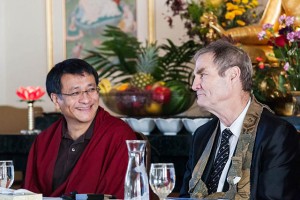
Dzogchen Ponlop Rinpoche, and Zen teacher John Tarrant Roshi, at the 10th anniversary event at Nalanda West.
The biggest physical improvement to the property since then was the addition of an apartment, above the shrine room on the third floor, for a 2008 visit from the 17th Karmapa. Ponlop Rinpoche designed the apartment, which features hand-carved, wooden sliding doors with Japanese glass, thangkas, and a shrine with statues of Milarepa, Marpa and Gampopa.
Now the sangha is looking ahead.
“Rinpoche talked to us from the beginning about imagining this institution as a 100-year project,” Shelton said. “It would be something that really functioned to benefit our world, not just the students … As it grew, it would be really integrated into the community. He felt that was really important.”
Damayonti Sengupta, Nalanda West’s general manager, is working to expand the center’s visibility in the nearby Fremont and Wallingford neighborhoods. “We want to be a resource in the community, as a place you can offer a retreat, or invite somebody to teach,” she said.
The center already rents its spaces – the shrine room, dining room, and a more intimate room called the Vajra Spot – to groups such as Seattle Insight Meditation, Dharma Ocean, Sufi Way, and presenters of Feldenkrais and yoga events.
“I want it to be more warm and friendly,” Sengupta said. “When you look at the Nalanda West website, it says this is ‘your resource for a contemplative life.’ Anyone can meditate, anyone can improve their lives through our programs. This is where you can go. You don’t have to be Buddhist.”
